Meet the golf course manager: Dave Gibbons
Related Articles
Dave, from Little Aston Golf Club in Sutton Coldfield, talks about greenkeeping during a pandemic, the cultivars he uses to maintain a healthy surface and the biology used to improve the soil profile on the course’s greens.
Currently ranked as one of the top 50 golf courses in the whole of England, Little Aston Golf Club is set in 176 acres of tranquil, mature parkland in the former grounds of Little Aston Hall, eight miles north of Birmingham city centre.
Two legendary designers created the course: Harry Vardon laid it out in 1908 and Harry Colt later helped convert into the gem that exists today, including trademark Colt bunkers.
We speak to course manager, Dave Gibbons, about the challenges involved in ensuring this course retains the strong reputation it has had for over 100 years.

Hi Dave, can you explain how you started off as a greenkeeper and your journey to becoming a course manager?
I started playing golf when I was about nine years old. My dad and grandad introduced me to the sport as they were members at Pype Hayes Golf Club in Birmingham. At the time of leaving school I was interested in becoming a PGA assistant golfer. However, my handicap was too high, and the PGA wrote back to me and suggested to try greenkeeping. I was put into contact with Rhys Thomas who was the head greenkeeper at Great Barr Golf Club in 1995.
Rhys gave me an opportunity; he was a hard taskmaster but a good role model for me and I am very grateful to him for helping me in those early years. I used to work four days and attended college in Wolverhampton one day a week to gain my NVQ level 2 and PA1 PA2 in the first two years, in the third year I completed a NVQ level 3, this completed my apprenticeship scheme. I was kept on as a full-time greenkeeper at Great Barr. In 2000 I started college in Warwickshire one day a week to gain a HNC in 2002. I was then promoted to deputy head greenkeeper at Great Barr in 2002 and shortly afterwards in 2004 moved jobs to Little Aston Golf Club to be deputy head greenkeeper.
I worked under a very experienced head greenkeeper, Andrew Boraston, he had a huge amount of knowledge and was always happy to share it with you. I started distant learning at Myerscough College in 2004, studying towards a foundation degree. I then successfully applied for a Jacobsen scholarship in 2006 to help fund my BSc honours degree.
This took a further two years online to gain, graduating in 2008. I tried hard to become a course manager from around 2012, applying for a handful of local vacancies sometimes getting down to the last two but never being chosen. Eventually I got a chance in 2016 and left Little Aston to become a course manager for the first time at Walmley Golf Club. Walmley is a good club and keen to keep improving, it was an exciting six months, then the opportunity arose at Little Aston later in 2016 as the course manager. Including my time spent as a deputy and course manager combined, I have now worked at Little Aston Golf Club for over 15 years.
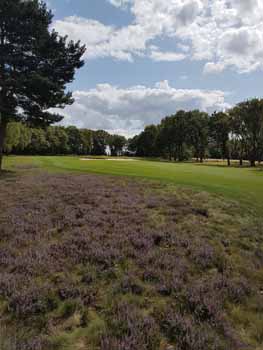
What is the current size of your team?
We have an experienced team of six that always works hard and communicates well with each other. I am lucky to have a supportive deputy and a good team, I’m very grateful to all of them for their efforts and pride that they show in their work. Without their help nothing is achievable on the golf course:
- Deputy Craig Hartley
- First assistant Gareth Morgan
- Assistant James Newbold
- Assistant Rob Taylor
- Assistant Alan Gee.
We work as a team and although we all have jobs that we are stronger at, all the common tasks are shared around to help keep the team engaged. We go for occasional breakfasts and Christmas meals / drinks. We are a friendly, dynamic team and will always help each other to present the course the best we can for the members and visitors.
Two days per week we have gardeners who look after the putting green flower beds and the green staff look after the surrounding turf; this combination helps keep the famous putting green tidy and in good condition.
The green staff rake all the bunkers and strim the grass tongues. There are also 37 artisans who trim and weed the bunkers on the course in return for a free game of golf. They have been at the club for decades and their work is always very appreciated by the members and the grounds staff.
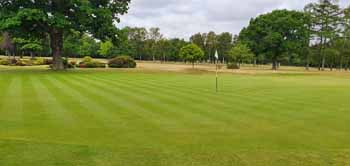
What are the biggest challenges you face in maintaining the course and what additional challenges have you faced throughout the pandemic?
The biggest challenges for us are on the course – the turf surfaces and keeping them healthy is a challenge 12 months of the year as we are working with nature and everything it throws at you. There generally is not a calendar month where you can switch off and think that the greens will be okay for now. We have turf disease, wildlife, woodlands, and the weather that’s constantly causing issues around the course but that is what makes this job so interesting and challenging.
Other challenges include the machinery, we do not have a qualified mechanic on site, but the team has a good level of mechanical skills to help where possible to keep the machinery in good condition.
When the course closed for the first lockdown it was strange, as nothing like that had ever happened before, so we were a bit nervous. We had two staff working together for the first three weeks, just looking after the basic tasks so that the course did not become unruly. When the staff returned and the course re-opened, we split into two lots of three for start times. The disinfecting of machinery after washing them off and social distancing also followed, with other measures put into place to try and keep everyone safe and to allow the team to feel comfortable while at work.

You’ve set in motion a bunker programme. Can you tell us more about this?
Little Aston has 87 bunkers on the golf course and three practice bunkers. Anyone who has played golf at Little Aston will know that some of the fairway bunkers are really big and have very high sand faces due to its designers Harry Vardon and Harry Colt. We are currently carrying out the rebuilding of the vast majority of these bunkers and re-sanding a few that have been built in the last 10 years. The work is carried out in-house which will take us around eight years. In 2017 the club had an architect review of the bunkers carried out by Martin Ebert and following on from this in October 2018 we started to rebuild the first set of bunkers. The visual impact and playing ability of the new bunkers is a positive improvement seen by everyone. We have currently rebuilt / re-sanded 30 bunkers on the course and one practice bunker. We have a good team who can all participate in building the bunkers as needed, we also have a good shaper in Craig who also helped build bunkers at Blackwell Golf Club over the last few years. We have learnt and changed a few ways we do things, but we now have a good idea of the cost involved, materials to use and the method of building a bunker.

You chose to transition to Germinal cultivars, what were the reasons for this and what were you looking to achieve?
It’s important to look at different products so that you can see if they work better than the ones you are using. Technology is always advancing, especially with grass seeds, so it’s important to keep up to date with new cultivars and mixes that are relevant to the course that you work at. It is simply that we have decided to change to a different seed supplier and so far, we have been happy with the results.
We look to achieve a healthy even sward and to improve surfaces all the time. I believe that by using Germinal grass seed we are achieving this.

What cultivars did you finally choose, which areas of the course have you focussed on and what results have you seen?
We used Germinal Abermajesty on the greens in 2019 but in 2020 we tried Germinal Forefront Greens and 007. The rate of germination is good and the seeds match well with the established surfaces alrady at Little Aston Golf Club. We also have been using Germinal A28 on the tees only – it’s 25 percent ultra-fine ryegrass mixed with fescue, this really helps with divot recovery and again blends into the existing award.
On the fairways and roughs we use Germinal A27 (pure fescue), this has been a great seed as well and again germination rates are good and match the existing turf well.
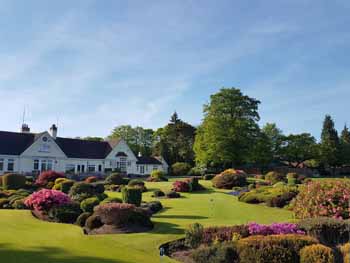
How would you describe your overall experience of the Germinal product and service and what has this delivered to you, the course and the playing surfaces for the members?
Germinal provides a friendly, professional service and the products that we have used have been of a high standard. The seed germination is very good and this has helped the team keep the surfaces in a good condition for the golfers even during periods of heavy play like the summer of 2020.
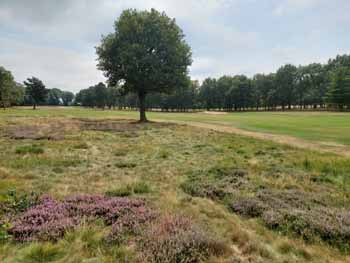
You’re starting to look at soil biology as means to support plant health and fight against disease. What have been your reasons for doing this?
In December 2019 we started using several soil biology products to help improve the soil profile on the greens. We since have been using a larger scale of soil biology products which are helping to support the greens’ biological health.
In the last 12 months we applied three fungicides (we applied eight from December 2018 to November 2019). The fungicides we used struggled to prevent or stop turf diseases, so we decided to try a different approach.
In the last 15 years many fungicides have been removed, we started looking into other ways to help. By using soil biology, we are aiming to increase the natural resistance in a soil profile. We are now using the fungicides mixed with a soil biology product to support the turf during high risk periods for disease. .

What aeration programmes do you run, how do you determine what the course needs and when, and what are your preferred methods?
Each year the club sets one week in March and one week in August to allow the greens to be aerated and top-dressed. On both these occasions deep aeration is carried out; either solid or hollow tines are used. A Graden machine is also hired either each year or every other year to help control the top 20mm of organic matter. Also, throughout the year we use an Air2g2 machine, pencil tining, sorrel rolling and star slitting. The fairways are normally Verti-drained each year by contractors or deep slit in house. Areas such as tees are tined twice a year and the surrounds are hollow tined and solid tined annually too.

What irrigation set up does the course currently have, where is water drawn from and are there any further plans for irrigation to increase efficiency?
The irrigation system is a modern Rain Bird system. It was designed by Irritech and installed in 2015 by Irrigation Control. We have the Rain Bird Stratus 2 software installed, which is relatively easy to use along with the use of mobile Mi as well. We have greens, tees and aprons fully covered with automatic sprinkler heads. There is no fairway irrigation installed but the club may install a few valve boxes near to where some of the fairways are prone to badly drying out. This would allow us to irrigate these areas if needed. We use mains and bore hole water which are mixed inside the 28,000 gallon water storage tank.

What height of cut do you use?
Our height of cuts are:
Greens: 3-6mm. Tees: 11mm. Aprons: 8-11mm. Fairways: 14-17mm. Semi rough: 38mm. Rough: 75mm.
What do you think are the strengths that have carried you through your career?
I have no doubt that playing golf and having an interest in the game has helped me in my career. From a young age I was taught never to give up and to work hard to achieve your ambitions. Both these principles have helped drive me on. Also leading by example, being polite and fair are other attributes that have helped carry me through my career. I am also lucky to have a great wife who always supports me.

Drainage presents challenges to many course managers. What drainage issues does the course suffer and which areas of the course in particular are presenting challenges to you?
The course does drain relatively well, there are some wetter low areas which at times can become soft but all in all the land was chosen well for the course to be built on. There are two lakes, one large and one small, on the course with a small brook that runs adjacent to the 12th hole. These water courses help with the movement of water from the course. The greens can get a bit soft and heavy as some are push-up greens, but they do drain reasonably well and again cause few problems. A drainage problem that does exist is the bunkers flooding, as most of the bunkers are the original ones, some of the bases are below ground level with no drainage in them and with decades of sand compaction in them they drain poorly. As we are building the bunkers, we are making sure that they have drainage installed using white-moss mega flow pipes.
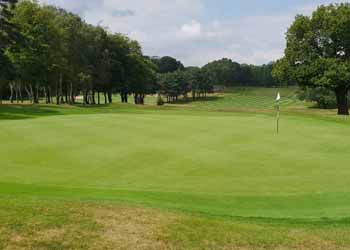
What machinery fleet are you currently using?
Machinery is very important as you need good quality machinery to help keep the course looking tidy.
The club has always owned Toro mowing equipment due to their reliability, nowadays the club leases the mowers over a five-year period and this works well as it keeps all the mowing fleet in a better condition. In 2018 the club invested in Bernhard grinders, which have been a great help to us, we have a Alan and James who are trained to grind.
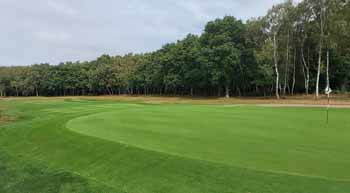
The course has a significant number of trees. What tree management programme is in place and what are the challenges the woodland currently presents to the well-being of the course?
Little Aston has tree-lined fairways on most holes on the course, these include many different species of trees which frame each hole beautifully. However, like all vegetation, it needs a certain degree of management to keep it healthy and in order. Each January we have a couple of weeks where we hire in a chipper for clearing out the under canopy of the woodlands.
In 2013 STRI carried out an ecological survey of the course. This survey has been used as a guide to manage the woodlands and heather.
In 2019 the club had a tree survey carried out, this was to identify any dangerous trees that were near to buildings, greens and boundaries. Each year a local tree surgeon carries out work based off this survey to help keep the trees safe.

You view how you treat people in the team as very important and that training and education is an essential part of an individual’s evolution and development. Please can you explain how you have educated yourself.
You have to treat people the way you expect to be treated and speak to people the way you wish to be spoken to. This is the way respect is earnt, regardless of position.
When I left school I never expected to go on and gain a degree, if you are passionate about what you are doing, anything is possible. By achieving qualifications like this, it has helped me to get on in my career and progress to being a course manager on a championship golf course today. If you are looking to develop, signing up to a college/university course try and stay in the workplace at the same time this will help give you the practical experience needed.

The pressures on the course manager to deliver a better product are growing year on year and the level of professionalism is rising with this. What do you think are the qualities now needed to meet the demands of golfers by someone in your position and how does this help contribute to the business of golf?
Unfortunately, pressure is going to be part of any managerial job, you must understand this when you apply for the position. When things do not go the way you plan, or the results are not as good as we expected do not let it get to you You can never get the course perfect as there are so many things that affect this that are out of your control.
You have a great relationship with your greens chairman. How often do you speak and how has this helped the club?
The greens chairman and the club manager, Iain Burns, have both been supportive. Most weeks the greens chairman will phone me up to ask how we are all going, what we’re all doing on the course, and to mention any issues that he has so they can be dealt with. We have a greens meeting every three months which again helps to review what work has been carried and if it can be improved on and so on, also it’s a chance to plan ahead for future work. When you have good relationships and structure to a club with everyone pulling in the same direction it becomes easier to get jobs done and therefore raise the standard of the course.
What gives you the greatest satisfaction from your job?
It is always satisfying when the course is looking great and golfers are telling the green staff on the course how good it is. It is also satisfying when the club manager or greens chairman pass on positive feedback to the team from members, golf days and visitors. When you drive around the course on a Friday afternoon and it’s well presented it gives you a sense of pride and achievement to know that all of the hard work that the team has put in can be seen and enjoyed by the golfers.
In 2008 when I was deputy at Little Aston, I was given the task to develop and establish heather on certain holes on the course. This was a new skill to me so the first thing I remember doing was buying a book about heather on a golf course and how to look after it. We started by stripping turf off that had already been stripped before, but unsuccessfully, and seeding it up with heather seed from Enville Golf Club. We even brought small heather plants in from Scotland to help boost the heather establishment. Years were spent developing those heather areas and it’s great to see all the areas are naturally fitting into the course and look like they have been there for a long time.
Another good achievement was having the three wettest greens on the course pipe drained. PDS Contractors did a great job installing the drainage systems and our team completed the final levelling of the rootzone and re-turfing the drain lines to a high standard. This has helped keep all 18 greens surfaces dry out in a similar time.
The biggest achievement to date is being part of the bunker rebuilding project, planning the work, running the budget, ordering of materials, and then being involved in building the bunkers has been fantastic. We build them with drains or sumps and follow the same principles such as high faces like the old bunkers but with a more modern feel.

What are the most memorable lessons you have been taught in your career and by whom, and with your years of experience, what advice would you give to youngsters starting out and wanting to pursue a career in the profession?
I was lucky to start my career working for a good golf club with an ambitious head greenkeeper. High standards were drilled into my work from the beginning and opportunities to participate in regional golf days, Harrogate and Saltex were always encouraged. I made mistakes. I remember once when I was serving my apprenticeship I felt like quitting, I asked myself ‘am I good enough?’ I did not quit, instead I got my head down and got stuck in and pushed myself to improve with an ambition one day to become a course manager.
We have a young assistant, he is a terrific greenkeeper with loads of potential, I often ask what his aims are and how can he make them happen,
My advice to anyone starting out in greenkeeping is do not rush to become a course manager, take your time, and learn your trade. Work for different managers and clubs to gain experience.
Volunteering for tournaments is now more available to do than ever. Being a greenkeeper on a golf course is a great job it can be very satisfying and enjoyable whatever your position is.
What changes do you think need to be made to benefit the industry sector and profession of the greenkeeper?
Technology has come a long way in the 25 years that I have been in this industry, not just the equipment that we use to maintain the course but the products too. It would be great to see grass seed continue to develop towards being less susceptible to disease attacks to help balance having less chemicals available to spray. The need to continue to improve the way a golf course operates in an environmentally friendly way while still producing what the golfer wants is going to be the biggest test greenkeepers face in the future as restrictions increase and less chemicals are available to use.
You must look after yourself, I remind myself that as much as I want to do well at my job it’s important to spend quality time with my wife and four children.

























